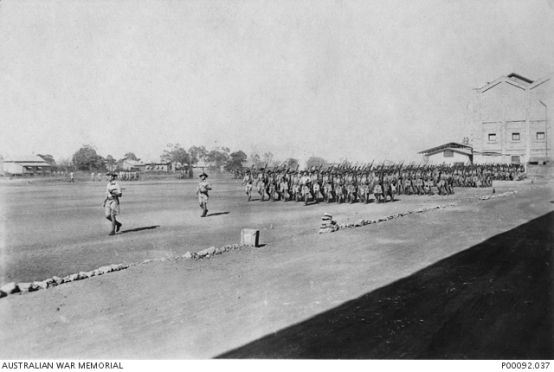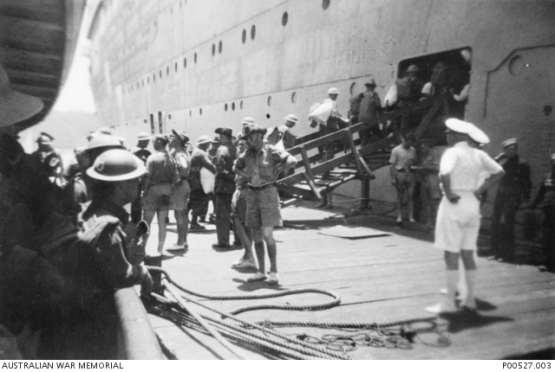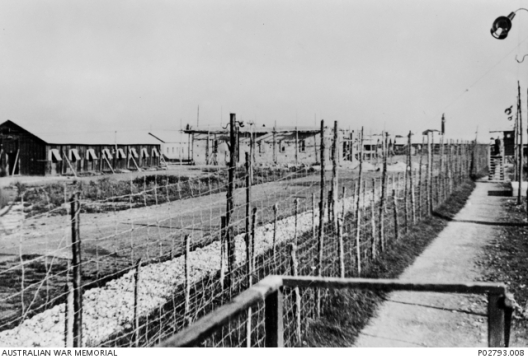 It has become a tradition among Australian and New Zealand genealogy bloggers to remember our ANZAC family members and others on Anzac Day each year. This is my contribution for 2017 – a man I knew nothing about until this week.
It has become a tradition among Australian and New Zealand genealogy bloggers to remember our ANZAC family members and others on Anzac Day each year. This is my contribution for 2017 – a man I knew nothing about until this week.
Hugh Augustine Moran was my mother’s first cousin, born in Ingham, Queensland on 6 April 1906[i] to James Hugh Moran and Bridget McSherry.

On 11 June 1940, Hugh enlisted to join the Australian Imperial Forces (AIF) in Cairns, Far North Queensland. His age is given on enlistment as 33 years 11 months, though he had only recently celebrated his 34th birthday[ii], had brown hair, blue eyes and a scar on his forehead. Hugh had been working as a labourer in Kirrima, Cardwell and had served 7 years with the citizen military forces (CMF). He was taken on strength with 2/15th Battalion.
The importance of reading the war diaries becomes apparent when we find that the 15th served garrison duty in Darwin for three months which is not noted on his file…you need to look at the big picture of the unit to discover the overall action plan.

Hugh’s file notes that he was marched out to East Command in December 1940, embarking for overseas on Boxing Day 1940. Meanwhile Hugh had treated himself to a pre-Christmas excursion without leave from Redbank on 22nd-23rd December for 28 hrs. He was duly fined, which probably didn’t bother him much if he had someone he wanted to see, or even if he wanted to have a drink or two, or more, to calm his jitters before heading overseas to battle.

The Australian War Memorial’s (AWM) brief history of the 2/15th tells us they sailed “aboard the Queen Mary with the 20th Brigade to Palestine via India, transhipping to the Rohna at Bombay. (OIC of the 15th, Lt Col R F Marlan was Officer Commanding Troops on the voyage).
The 20th Brigade transferred from the 7th to the 9th Division en route to the Middle East. It arrived at El Kantara in Egypt at the start of February 1941 and moved to Kilo 89 in Palestine for desert training.”[iii]
In March 1941 Hugh was attached briefly to the 2/23rd Battalion, 9th Division, for a month between 2 and 29 March when he returned to the 2/15th.
The 2/15th moved to Gabel El Gira on 27 March and then Barce. German forces had landed at Tripoli and were advancing east. It was involved in the withdrawal of British forces to Tobruk, referred to as the “Benghazi handicap”. The withdrawal cost the battalion heavily: the commanding officer (Lt Col Marlan), second in command (Major Barton), and 154 men were captured at El Gazala.
It was during this dash to take and hold Tobruk that Hugh was taken prisoner of war, between Derna and Barce in the Cyrenaica region of Libya. He was one of the 154 mentioned above. They had been caught in the aggressive attack by the great German soldier, Field Marshal Erwin Rommel aka the Desert Rat.
Rommel launched his assault on March 24, 1941, sending three mechanized columns rumbling northward and eastward. The fast-moving Germans chased the retreating British along the coast road, rolled into Benghazi, and swept on to Barce and Derna. One panzer column captured inland fuel dumps and burst out onto the coastal plain at Gazala. Another column executed a wide flanking movement to try to capture British units evacuating from Cyrenaica. The Allies were in full retreat, and it seemed as if nothing could halt Rommel’s advance[iv]. However Rommel was to later get his come-uppance at El Alamein at the hands of the British forces.

Hugh was reported Missing in Action, presumed Prisoner of War, effective 7 April 1941, and this was confirmed on 30 June 1941. Unfortunately, the WWII personnel files don’t include notifications to next of kin, and in fact we’re fortunate that this document had already been digitised.
It’s initially unclear whether Hugh was held as POW locally or taken directly to Italy. Once again he was unfortunate, because the camp to which he was sent, Campo 57 Gruppignano near Udine in north-east Italy, was under the command of former Italian Carabinieri officer,[v] Colonel Vittorio Calcaterra. He had been described by one prisoner as “a sadist and a beast and an accessory to murder”(no reference provided).

Thanks to Calcaterra, conditions in Campo 57 were extremely harsh. Food was poor, and housing was crowded and insanitary. The prisoners had to improvise their own medical treatment, coping with the “57 twins”, pneumonia and kidney disease…The number saved by Red Cross aid, he wrote, “is beyond computation”. Calcaterra died before he could be tried as a war criminal.
There is a wonderful sketch in this story, The Stolen Years, which graphically portrays the life of POWs at Campo 57. This article argues that soldiers may have been (somewhat) resigned to death or injury, but rarely thought about what they’d do if taken Prisoner of War and the psychological impact of that[vi]. It quotes one soldier’s experience but we have no idea whether this tallied with that of Hugh Moran:
When he finally reached his permanent camp of detention at PG 57 Gruppignano, where nearly all Australian and New Zealand other ranks had been concentrated, Ted Faulkes too, had to make a monumental change of attitude to different standards of hygiene, diet, discipline and organisation. But at least he was among his peers, and within the camp, responsive to the discipline of his own Australian NCOs as he basically he had been in battle. To some extent his individual temperament and personality had already been moulded by the structure and esprit de corps of his AIF unit – the 2/32nd Infantry Battalion.
The initial transport of POW from the battlefield is by military truck from a holding pen to a rear transit camp, where officers are separated from other ranks[vii]….They were moved either by boat or train (or presumably both in the case of those captured in North Africa).
We have no direct evidence of Hugh’s life in Campo 57 but the above stories and images reveal some of the experience.
Read Part II to learn more about phase 2 of Hugh’s war service and what happened to him after Italy.
And to learn about Hugh’s war in his own words, read here.
—————————-
[i] Military file on naa.gov.au and Queensland Birth registration C1750.
[ii] His medical inspection was on 1 June so perhaps that explains it.
[iii] https://www.awm.gov.au/unit/U56058/
[iv] http://warfarehistorynetwork.com/daily/wwii/debacle-in-the-desert-the-siege-of-tobruk/
[v] https://www.awm.gov.au/exhibitions/stolenyears/ww2/italy/story2.asp
[vi] http://www.aifpow.com/part_1__missing_in_action,_believed_pow/chapter_2__being_a_pow
[vii] http://www.aifpow.com/part_1__missing_in_action,_believed_pow/chapter_4__transportation_of_pow
A great tribute to Hugh and his war service. Don’t you love it when you find digitised WW2 personnel records. I look forward to reading part 2.
LikeLike
Thanks Kerryn…I had him only as a name on the tree so I was amazed as I discovered more and more info on him.
LikeLiked by 1 person
Thanks Pauline!. I met Hughie Moran in 1998 at his cousin Phyllis Roy’s (nee Jacobson) 80th birthday lunch. Phyllis was my father’s sister, which makes Hughie my 1st cousin once removed. 2 things I remember. 1. He looked a lot like my father, Peter Hart Jacobson, who had died a year earlier but was a taller, bigger version of him. Strangely he had the same habit of stroking his right cheek with his index finger as he spoke. The second thing I remember is Phyllis’s comment as she saw him again after a very long time. said with a giggle in her voice, “I thought you were dead!”
LikeLike
First hand knowledge…don’t have any pics do you? I have his date of death as 1995…will have to double check.
LikeLike
No, you are correct re his death. My memory had the wrong decade. I met him in 1988 at Phyllis’s 70th birthday. Confirmed with a daughter of aunty Phyllis. I did take photos that day so will check my old colour prints.
Thanks again for your fabulous research and enormous effort.
And sharing!
x
LikeLike
An excellent tribute to “a name on the tree”. Well written Pauleen, can’t wait for part 2.
LikeLiked by 1 person
Thanks so much!
LikeLike
While many that left for WW1 or WW2 like Hugh never knew what might happen to them exactly. So many started on the same route. It’s great you share some of their stories.
LikeLiked by 1 person
Great Work as usual Pauleen. 6th April is a special day to me too; My birthday and the day my grandfather died.
LikeLiked by 1 person
That must be tough to always remember your grandfather’s death on your birthday, especially if you were close.
LikeLike
Just had a skim through this. Hoping to find time to digest fully later in the week.
LikeLiked by 1 person
Love the detail, as always… on to Part II…
LikeLiked by 1 person
I have included your blogs, I & II in INTERESTING BLOGS in FRIDAY FOSSICKING at
http://thatmomentintime-crissouli.blogspot.com.au/2017/04/friday-fossicking-28th-april-2017.html
Thank you, Chris
LikeLike
Cousin Pauleen, thank you!!!!! I had lost your email so I’m glad Bev has sent this out. I can imagine our g-grandfather Peter will be taking all the credit for his talented descendants. I think I have a trove article about Bridget in Cairns at some stage. You probably have it too. Thanks again for Hugh’s part one story. Cheers
Jeanette
LikeLiked by 1 person
Thanks for visiting Jeanette….those McSherry/Callaghan/Furlong genes do a pretty good job, don’t they?! Trove is beyond amazing…what a gift it is to all researchers…..love it!
LikeLike
One of Mary/Maria Reddan & Daniel Meehan’s children married a Moran.
LikeLike